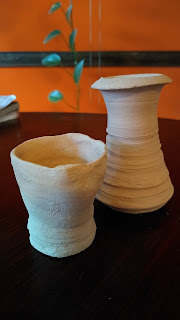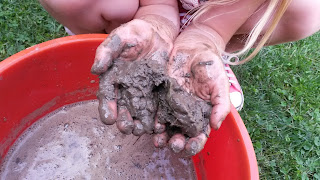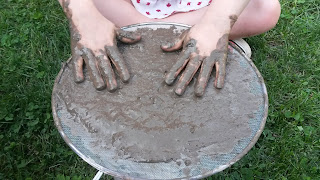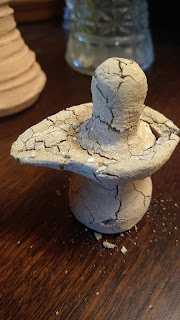River Clay (or is it just mud?)
Three years ago my daughter and I went to the Humber river to find some clay.
And just last week(!), we finally fired the things we made out of that mud/clay.
It took three years not because it needed to, but simply because... well, time passed and we finally got around to finishing the process. :) There's something nice about doing things only when you want to, and not when you're supposed to.
So here we are in 2017, digging up mud near the shore. We didn't make any special effort to find what looked like good clay; we just dug up mud to see how it would work.
Back home, we took the mud we had collected and sieved it to get rid of rocks and other junk material.
 |
| Little seeds started sprouting a short time later. |
Then in June of this year, we took that mud and made stuff out of it. A few thumb pots, a kitty cat and cat bed...
...a few molds.
It was great to compare the good clay with the river mud; to see how malleable and giving one is compared to the other, how gritty the mud was compared to the clay, etc. It's one thing to know this and really another to feel it.
And then this month we gathered up all the pieces, Humber-mud and store-clay, and loaded the kiln.
There were a few leaf-print tiles and two pieces I made with my homemade mop-bucket potters' wheel: a very thick little vase and a thin-walled cup that I kept even though it got mangled when I tried to remove it from the wheel.
And then we fired it up! It took about 6 hours, so we had time to play and actually finish Snakes and Ladders.
We got up to 970° C and stopped.
And the next morning we got this:
 |
| Jorge's kids made these years ago. |
 |
| the two homemade potters' wheel pieces |
And it brought to mind once again that great story of the Popol Vuh from Silo's Universal Root Myths, written in a 'pre-ceramic time of dried clay':
"As dawn approached, the Makers said that they must hurry and try again [to make a creature that could invoke them]. Then they made a man of mud, but he could move neither his head nor his limbs. He could speak, though he had no understanding. He lasted for a time, but then became wet and could no longer stand erect. And so they undid their work and took counsel together..."
Much importance in pyro-history is placed on being able to reach the necessary temperature, to convert clay to ceramic, for example. But with this we learned that having the right material is equally important because if all you have is sand and silt without silica and alumina, even at 970° C, you're not going get ceramic.
It took three years to do the whole process, but what's the rush when you're having fun?

























Wise and funny like always! I love it!
ReplyDelete